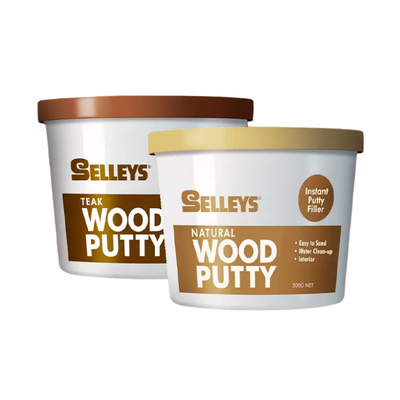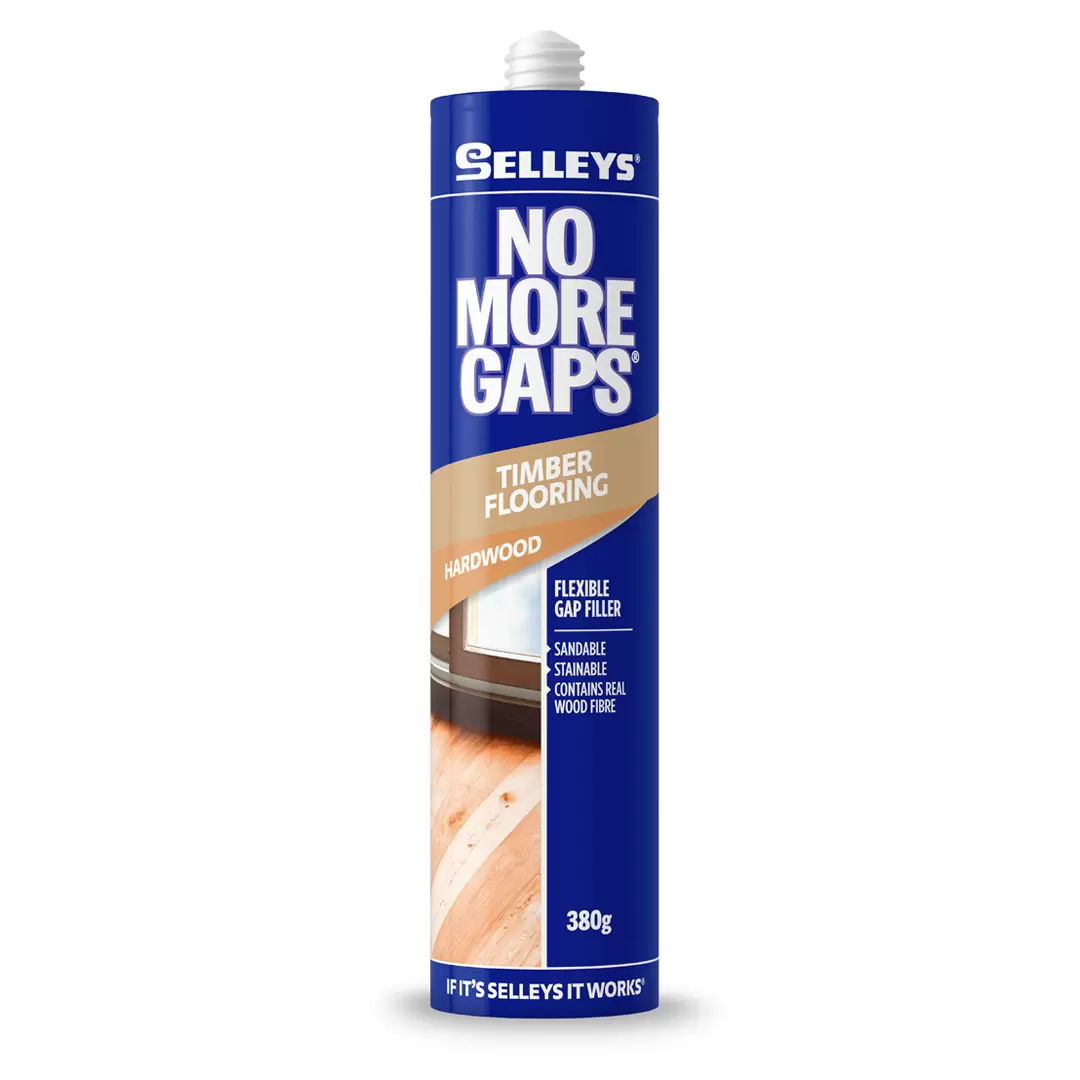Admiring your woodworking project and noticed some dents and cracks that need repairing? Not to worry, there are several products to help you cover the imperfections! In particular, wood putty or filler is commonly used to restore woodwork.
Learn about the differences between wood putty and fillers to choose the most suitable product for your project.
Table of Contents
What Is Wood Putty?
Wood putty is a malleable material made from a combination of oil-based solvents and plastic. It’s often used to fill cracks in finished surfaces such as holes in wooden flooring.
If you need to repair woodwork, Selleys Wood Putty will help you complete the job effortlessly. Pre-mixed and ready to use, it can be easily sanded, painted or varnished.
Additionally, it’s available in 2 different tints – teak and natural, so you can find a suitable shade to match your piece.
Types of wood putty
There are 3 common types of wood putty – nitrocellulose-based, water-based and oil-based. Find out more about their properties below.
| Nitrocellulose-based wood putty | Water-based wood putty | Oil-based wood putty |
|---|---|---|
What Is Wood Filler?
Wood filler is made from wood fibres such as sawdust. It hardens quickly and is most suitable for filling imperfections in both finished and unfinished wood.
Selleys No More Gaps Timber Floor is designed to fill gaps in surfaces made from materials such as walnut, jarrah, hardwood and baltic. It’s made of real wood fibre that absorbs stains much better than standard gap fillers.
Furthermore, it can be sanded to achieve a smooth finish. It’s the ideal solution for improving the aesthetics of fittings, panels and floorings.
Types of wood fillers
Oil-based and water-based wood fillers are the most common types of wood fillers available on the market. Here are some of their differences.
| Oil-based wood filler | Water-based wood filler |
|---|---|
Comparing Wood Putty vs Wood Filler
While both products can be used to repair wood surfaces, they each have their unique properties.
| Wood putty | Wood filler | |
|---|---|---|
| Price | From $2 | From $4 |
| Adhesion | Has adhesive properties | Little to no adhesive properties |
| Colours | Range of colours varies across brands; generally available in various shades | Available in a variety of colours |
| Drying time | ||
| Flexibility | Flexible | Both flexible and non-flexible options are available |
Price
The cost of wood filler and putty varies depending on factors such as the brand and place of purchase. Wood putty is generally cheaper – usually starting from $2, while the price of a wood filler starts from $4.
Some retailers offer wholesale prices for bulk purchases. Thus, you can save money buying in bulk if you engage in woodworking projects frequently.
Adhesion
Wood putty has adhesive properties so sealing typically isn’t required. On the other hand, wood filler lacks adhesive properties and may need to be sealed to ensure that it doesn’t come loose.
Colours
Wood putty doesn’t absorb stains well and may turn into a different colour when it dries. That’s why they’re usually available in various shades like cherry and walnut, so that it’s easier to find one that matches your project. However, the range of colours can vary depending on the brand you choose. Some brands may offer a wider range of colours to choose from, while others may have a more limited selection.
In contrast, wood fillers come in a variety of colours. They can also be painted over or mixed with stains to match the colour of the surrounding wood.
Drying time
The chemical composition of wood putty results in a longer drying time. Nitrocellulose-based putty takes approximately 10 minutes to harden. On the other hand, water-based wood putty takes up to 24 hours to dry while oil-based products require up to 48 hours.
Wood fillers have a much shorter drying time. It takes less than an hour for water-based fillers to harden and up to 6 hours for oil-based fillers to dry.
Take note that the drying time may vary depending on the temperature of the surroundings, humidity level, and amount of product used.
Flexibility
Wood putty consists of synthetic materials such as polyurethane, which allows it to remain malleable after drying. While some types of wood filler may harden after application, Selleys No More Gaps Timber Floor offers exceptional stretch capability to cater for any movement that may occur. It’s specially formulated for filling and sealing gaps where extra flexibility is required.
Choosing Between Wood Putty And Wood Filler
Want to know whether you should use a wood putty or wood filler? This table shows the product suitable for each situation:
| Dents, cracks, small holes in finished furniture | ||
| Dents, cracks, small holes in unfinished furniture | ||
| Flooring | ||
| Outdoor projects |
When to use wood putty
Wood putty is great for filling minor imperfections in finished furniture, flooring and outdoor projects. If you’re unsure of how to apply it, just follow these steps!
How to use wood putty
Wood putty is easy to use. You only need to prepare a few basic tools before starting:
- A damp cloth
- A putty knife
- A scraper
- Sandpaper/sanding block
Step 1: Clean the surface to remove dirt
Impurities can result in an uneven finish and increase the drying time of your application. Make sure to clean the surface with a damp cloth to remove any dust and dirt before applying the wood putty.
Step 2: Apply wood putty with a putty knife
Apply the wood putty to your project. You can use a putty knife, cotton swab, spatula or even your fingers.
Step 3: Remove any excess putty
Use a scraper to remove any excess putty as it can cause the surface to look messy and unprofessional.
Step 4: Leave it to dry
The drying time depends on the type of product and the thickness of the application. Generally, thin applications require a shorter drying time of about 2 hours. Thicker applications will take longer to dry.
To test if the putty has dried, rub it with your finger. If there’s no residue on your finger, the product has dried.
Step 5: Sand the wood putty
Sanding is crucial to ensure that the finished product looks professional and smooth. Level the surface with sandpaper or a sanding block to create a more uniform finish.
When to use wood filler
As wood fillers don’t contain harmful compounds that can damage raw wood, it’s great for filling holes or gaps in finished and unfinished furniture and flooring.
How to use wood filler
Wood fillers are easy to work with. Make sure you have these tools ready before you start:
- A scraper
- Sandpaper
- A damp tack cloth
- A putty knife/caulking gun
- Wood stain
- A paintbrush
Step 1: Prep the surface
Remove any splinters or paint chips from the surface with a scraper. If necessary, sand the surface to smoothen out any rough edges. Clean the area with a damp tack cloth and let it dry.
Step 2: Squeeze the filler into the hole
If your filler comes in a tube, squeeze it into the hole and make sure that the deepest area is filled. Move from one end to the other to get a smooth and even fill. If the wood filler you’ve purchased comes in a tub or cartridge, use a putty knife or a caulking gun respectively to apply it.
Step 3: Overfill the hole
Wood filler shrinks a little when it dries. Hence, it’s important to fill the area slightly higher than the surrounding surface. To ensure an even finish, overfill the area by about 5%.
Step 4: Smooth it out with a putty knife
Smooth out the area with a putty knife.
Step 5: Leave it to dry
Allow the filler to dry. Thin applications usually dry in under 30 minutes while thicker applications can take up to 8 hours.
To test if the area has dried, rub it with your finger. If it’s hard to the touch, the application has completely dried.
Step 6: Sand down the filler
Sand the filler with sandpaper until it’s level with the surrounding wood.
Step 7: Stain the wood filler
Staining is used to colour the wood filler so that the filler matches the rest of the wood.
Start by selecting a stain that’s closest to the original colour of your woodworking project. You can do so by dipping a paintbrush into the stain and applying it on an inconspicuous area to see if the colour matches. Alternatively, you can paint over spare pieces of wood similar to the one you’re working on.
If you’re satisfied with the colour, apply the stain with a sponge brush or a small paintbrush. If you’ve made a mistake while painting, a stain stripper can help to remove the unwanted stain and allow you to rework the area.
FAQs About Wood Putty vs Wood Filler
What is the difference between a putty and a filler?
Though both products can be used to repair damages and fill holes in wood, there are some key differences. Wood putty is used to repair minor flaws in finished wood while wood filler can be used on both finished and unfinished wood.
What are the different types of wood putty?
There are 3 common types of wood putty: nitrocellulose-based, water-based and oil-based putty.
Nitrocellulose-based wood putty dries quickly and can be cleaned with acetone or lacquer before it cures. It’s a great solution for urgent projects.
In contrast, water-based and oil-based putty is ideal for projects that don’t have to be completed quickly. Water-based products take up to 24 hours to dry and can be easily cleaned with water. Oil-based putty typically takes about 48 hours to dry and can only be cleaned with oil solvents like turpentine.
How long does wood putty last?
Wood putty can last for up to 20 years when stored in a cool, dry place.
How long does wood filler last?
Unopened wood fillers can last 3 to 5 years. Before using, inspect the product for signs of spoilage. If the product shows signs of discolouration, has weird odours or no longer has a smooth texture, avoid using it.



